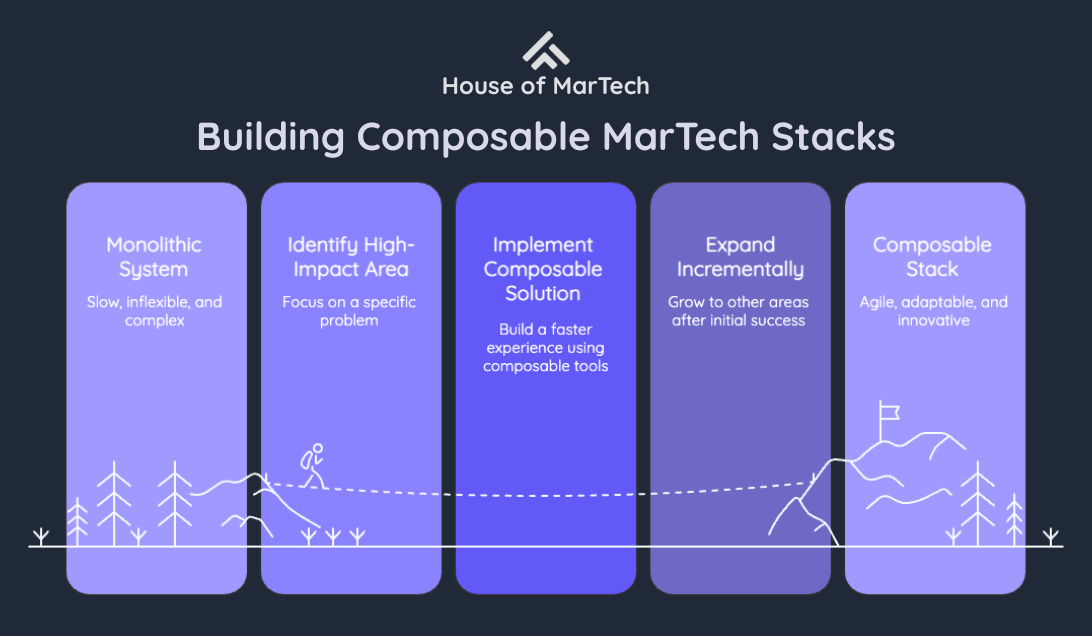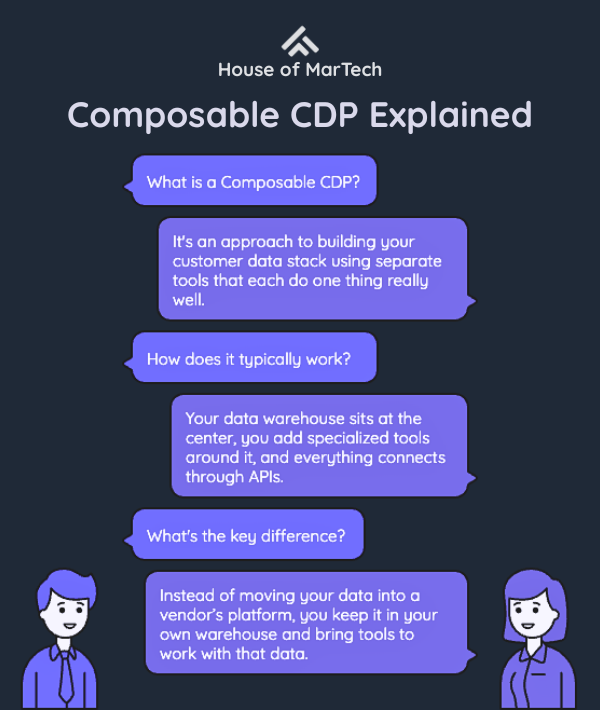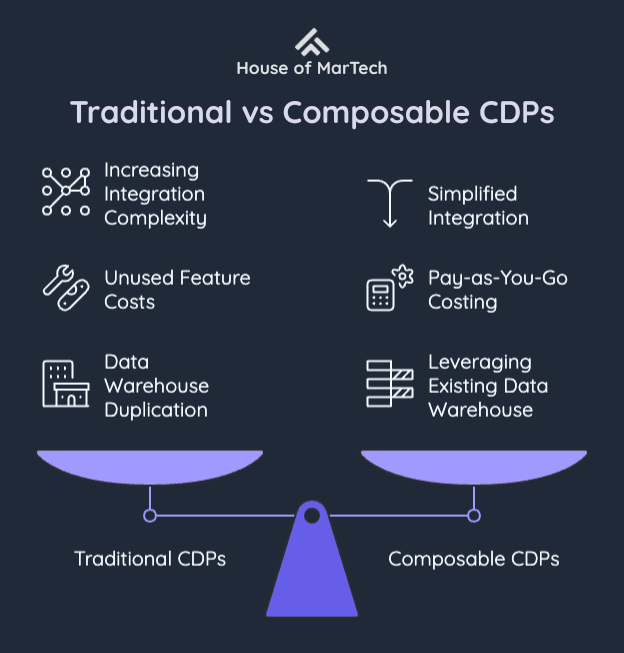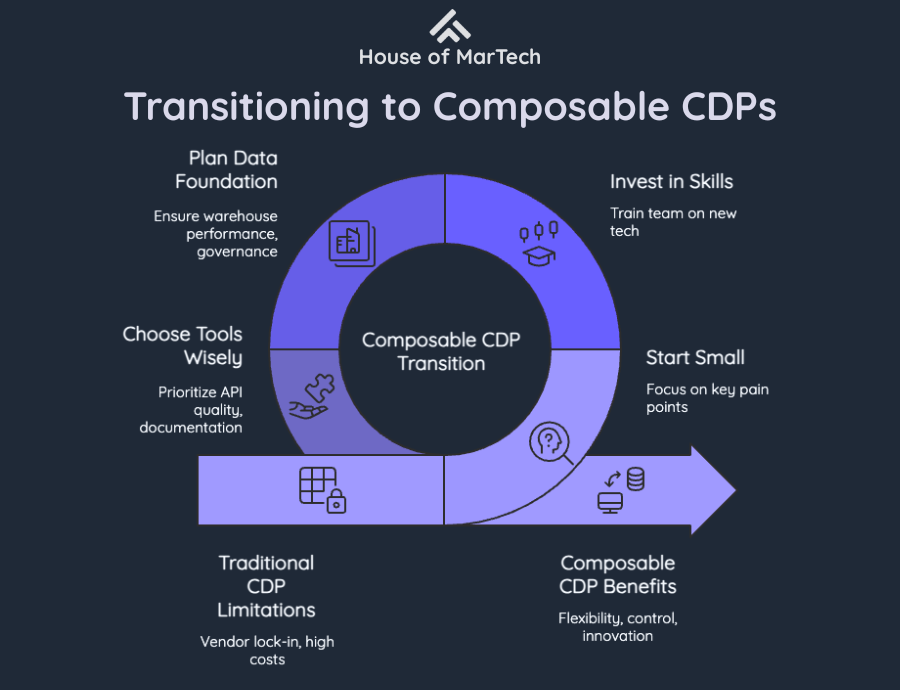The Rise of the Composable CDP
Choosing your data stack? Our expert guide compares the Composable CDP and packaged suites to help you build a future-proof MarTech architecture. Decide with confidence.

TL;DR
Quick Summary
The Rise of the Composable CDP
Quick Answer

Picture this: You've just spent six months evaluating customer data platforms.
You've sat through countless demos, reviewed feature matrices, and finally selected the "best" all-in-one solution. Fast forward 12 months, and your team is frustrated. The platform works, but it doesn't work the way your business actually operates.This scenario plays out in companies every day. It's why smart business leaders are looking at a different approach called the Composable CDP. Instead of buying one big platform that promises to do everything, you build your customer data solution using smaller, specialized tools that work together.
Think of it like building a home entertainment system. You could buy an all-in-one unit from one manufacturer, or you could choose the best speakers from one company, the best amplifier from another, and the best streaming device from a third. The second approach takes more planning, but you get exactly what you need. If you're evaluating your options, our guide on build or buy a CDP helps you make the right strategic decision.
What is a Composable CDP?

A Composable CDP isn't actually a single platform at all. It's an approach to building your customer data stack using separate tools that each do one thing really well.
Here's how it typically works:
Your data warehouse sits at the center. This might be Snowflake, Google BigQuery, or Amazon Redshift. All your customer data lives here in one place.
You add specialized tools around it. You might use Hightouch for sending data to marketing tools, Census for data activation, or dbt for data transformation.
Everything connects through APIs. These tools talk to each other and your warehouse through standard connections.
The key difference? Instead of moving your data into a vendor's platform, you keep it in your own warehouse and bring tools to work with that data.
Why Companies Are Making the Switch
The shift toward Composable CDP isn't happening because it's trendy. It's happening because traditional platforms create real business problems.
The Integration Problem Gets Worse, Not Better

Traditional customer data platforms promise to solve your integration challenges. But here's what actually happens: you end up with another system that needs to connect to everything else.
When you have four customer touchpoints, you need six connections between them. When you have twenty touchpoints, you need 200 connections. The complexity grows fast, and adding a CDP often makes it worse, not better.
You're Paying for Features You Don't Use
Most traditional CDPs charge based on how much data you have or how many customer profiles you store. You're paying for every feature whether you use it or not.
With composable approaches, you only pay for what you actually use. Need data activation but not journey orchestration? You only buy the data activation tool.
Your Data Warehouse Investment Pays Off
Most companies have already invested heavily in cloud data warehouses over the past few years. These systems can handle the complex customer data work that CDPs promise to do.
Why pay to duplicate that capability in another platform when you can build on what you already have?
How Leading Companies Are Building Composable Stacks
The most successful Composable CDP implementations don't try to replace everything at once. They start small and grow.
The Vitamin Shoppe's Smart Start
The Vitamin Shoppe faced a common problem: their old system was slow and couldn't handle the personalization their customers expected. Instead of ripping everything out and starting over, they took a different approach.
They started with one high-impact area: product search. They kept their existing systems running but built a new, faster search experience using composable tools. This gave customers immediate value while the team learned how to work with the new approach.
The results were clear quickly. Search got faster, customers found products more easily, and the team gained confidence in the composable approach. Only then did they expand to other areas.
LKQ Europe's Agility Focus
LKQ Europe operates across multiple countries with different customer needs. They realized that any traditional platform would require extensive customization to work across their diverse markets.
Instead, they built a composable stack that let each market adapt quickly to local customer needs. When the German team needed a specific customer communication workflow, they could build it without waiting for the platform vendor to customize their solution.
The key was starting with small wins that built trust across the organization. Each success made it easier to get support for the next improvement.
Diageo's Governance Innovation
Diageo's experience shows how composable approaches can actually improve coordination across teams, not make it more complex.
They created shared libraries and clear guidelines that let different teams work independently while maintaining consistency. Instead of everyone waiting for the central platform team to make changes, individual teams could move quickly within clear boundaries.
This approach required more upfront planning than a traditional platform implementation. But it enabled much faster innovation once the foundation was in place.
The Real Benefits Go Beyond Technology
Companies switching to Composable CDP report benefits that go far beyond the technical advantages.
Teams Learn and Adapt Faster
When your team builds and maintains your customer data stack, they understand it deeply. They can troubleshoot problems quickly, adapt to new requirements, and optimize performance without depending on vendor support.
This knowledge stays in your organization even if individual tools change. Your team's expertise becomes a competitive advantage that can't be easily copied.
Innovation Happens at Your Speed
Traditional platforms release new features on their schedule, not yours. With composable approaches, you can add new capabilities as soon as you need them.
Need to support a new marketing channel that just launched? You can integrate it immediately instead of waiting for your platform vendor to build support.
Costs Stay Predictable
Traditional CDP pricing can surprise you as your data grows. Usage-based pricing often leads to unexpected bills when your business takes off.
Composable approaches let you control costs more precisely. You can see exactly what each capability costs and make informed decisions about where to invest.
Making the Composable Transition Work

The companies that succeed with Composable CDP share some common approaches.
Start With Your Biggest Pain Point
Don't try to replace your entire customer data stack at once. Pick the area where your current solution causes the most frustration and start there.
Maybe it's slow report generation, or difficulty getting data to your email platform, or challenges with customer segmentation. Build a composable solution for that one problem first.
Invest in Your Team's Skills
Composable approaches require more technical knowledge than traditional platforms. Your team needs to understand APIs, data modeling, and integration patterns.
This investment pays off, but it's real work. Budget time and resources for training and expect a learning curve.
Plan Your Data Foundation
Your data warehouse becomes the heart of your composable stack. Make sure it can handle the performance requirements you'll need.
This often means investing in data modeling, governance processes, and monitoring tools. These foundational elements determine how well your composable approach works.
Choose Tools That Play Well Together
Not all tools work equally well in composable stacks. Look for vendors that prioritize API quality, offer good documentation, and have experience working with your data warehouse platform.
The best composable tools feel like they were designed to work together, even though they come from different vendors.
Common Mistakes to Avoid
Companies new to Composable CDP often make predictable mistakes that slow their progress.
Trying to Replicate Every Feature
Your old platform probably had features you never used. Don't assume you need to replicate everything in your new composable stack.
Focus on the capabilities that actually drive business value. You can always add more later if you need them.
Underestimating Integration Work
Composable approaches require more integration work upfront than traditional platforms. This isn't necessarily bad, but it's important to plan for it.
Budget extra time and resources for the initial setup. The payoff comes later in increased flexibility and lower ongoing costs.
Ignoring Data Governance
When data flows between multiple tools, governance becomes more important, not less important. You need clear processes for data quality, privacy compliance, and access control.
Don't wait until problems emerge to address governance. Build it into your composable approach from the beginning.
The Future is Already Here
The trend toward Composable CDP is accelerating, not slowing down. Several factors are driving this acceleration.
Data Warehouses Are Getting Smarter
Modern data warehouses can run sophisticated customer analytics, real-time personalization, and automated marketing campaigns directly on your data. This eliminates the performance delays that used to make separate CDPs necessary.
Teams Are Getting More Technical
Marketing and customer experience teams increasingly include people with technical skills. They can implement and manage composable solutions that would have required dedicated IT support in the past.
AI Changes Everything
Artificial intelligence works best when it has access to all your data, not just the subset that lives in a particular platform. Composable approaches make it easier to apply AI across your entire customer data set.
Is Composable Right for Your Business?
Composable CDP works best for companies that fit certain characteristics.
You have technical resources available. Either your marketing team includes technical people, or you have good support from your data or engineering teams.
You want to move fast. Traditional platform implementations can take months. Composable solutions often deliver value in weeks.
Your business is growing or changing quickly. If your customer data needs keep evolving, the flexibility of composable approaches provides real value.
You've already invested in a modern data warehouse. If your customer data already lives in Snowflake, BigQuery, or similar platforms, composable approaches build on that investment.
Getting Started
If you think Composable CDP might work for your business, here's how to begin.
Audit your current customer data challenges. What takes too long? What's too expensive? What capabilities are you missing?
Map your existing data infrastructure. What tools do you already have? How is your data currently organized?
Identify a pilot project. Pick one specific use case where a composable approach could deliver clear value quickly.
Talk to your team about capabilities and concerns. Do they have the skills needed? What support would they need?
Research vendors carefully. Not all tools that claim to support composable approaches actually work well together.
The rise of the Composable CDP represents more than just a new technology trend. It's a shift toward building customer data capabilities that truly fit your business instead of adapting your business to fit a platform.
The companies making this transition successfully are seeing benefits that go beyond cost savings or feature improvements. They're building organizational capabilities that become competitive advantages.
The question isn't whether composable approaches will become mainstream—they already are. The question is whether your organization will lead this transition or follow it.
At House of MarTech, we help companies navigate these decisions and implement the customer data strategies that best fit their business needs through our customer data platform services. Whether that's a traditional platform, a composable approach, or a hybrid solution, we focus on what actually works for your specific situation. Learn more about how to choose the right CDP for your business or explore our Tech Foundation Setup service if you're building from scratch.
The future of customer data is flexible, fast, and built on the foundation you already have. The companies that recognize this early will have significant advantages over those that stick with one-size-fits-all solutions.
Frequently Asked Questions
Get answers to common questions about this topic
Have more questions? We're here to help you succeed with your MarTech strategy. Get in touch
Related Articles
Need Help Implementing?
Get expert guidance on your MarTech strategy and implementation.
Get Free Audit